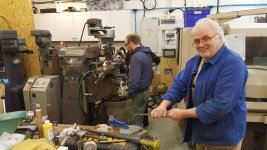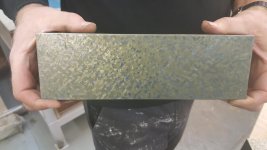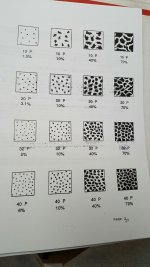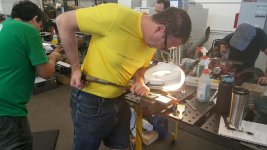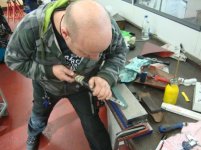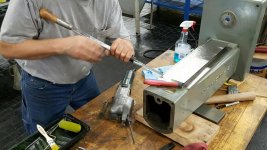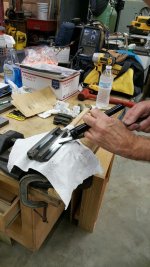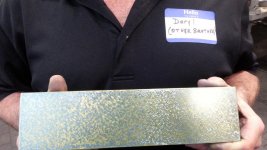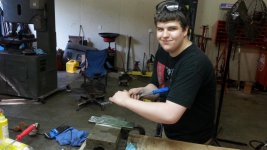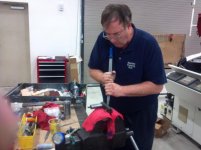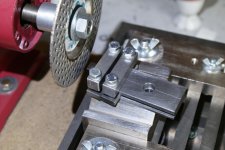Richard King
Diamond
- Joined
- Jul 12, 2005
- Location
- Cottage Grove, MN 55016
An analogy I can use is I was talking to my friend who is a Vet and he said "when a dog comes in and he was bitten by another dog and there is a cut" He stitches it up because the human owner wants it stitched up, but the dog will heel up without stitches. On ballens table that is scored it looks like the galls are on the bottom of the table and are not open to the air. I just went back and looked at the photo's and the galls are close to the ends but are not all the way out.
No one will see them under there...(like no one would see the cut in the dog under the hair). If the scores could let in more grit if they went all the way out to the edge I would fill them. If not all the way out then leave them and consider them as extra oil pocket or oil grove. You would stone the sharp edges off the scrores and put it back together after square cutting new oil pockets in the ways. As we discussed before the reason there is a score there is because oil did not reach that spot, right?
Now if they were on the bottom side and exposed to the air if the table moved out past them then I would fill them. In the old days when I was a kid working with my Dad we would use a mag base drill, center drill first and then drill holes and plug the scores with overlapping or stitched cast iron plugs. Or on some jobs we used a portable mill and milled out a slot and fit in a cast iron insert. Both were tedious as you had to sometimes drill air escape holes thru the casting so the plug would pound down into the hole, or file a small flat on the plug so the air would escape.
In later days we used metal fillers. I had a huge screw up when I used Belzona, had a Belzona rep help fill 1/4" galls in a BIG Giddings & Lewis Boring bar and it came out even with the bigger bottom ground holes or slots. But it was in a horrible contaminated with big chips area. So filling gals or scores all depends on what sort of machine and the place it is.
I started using the Devcon after having a failure also using Moglice Score EX and Multi-Fill..they have another name for it , but can't recall it's name now. I never had problems with the Devcon. I had experimented once with metal spraying scores after a rep swore it would work...another failure and Rep supervised us on it, so I would never recommend that either or welding.
For Ballen, no one will ever see under the table,so I would say leave them. If he was anal and wanted to fix it because it looks better when he see's it he could do it (like a stitch in the dog skin under the hair) :-) G-day Rich
PS: That same guy the Vet. His name is Lance and has become a heck of a good rebuilder. He assisted me at my last Keith Rucker Class and he bought a HKA-48 straight edge from me that had some voids in the flat. I had it down at Steve Watkins and he discovered they were to deep to plane out so I had to have another one made and sent to Steve. Anyway, Lance said he filled the pockets with solder. I have seen on some web-sites a new product that is a soft braze material. Must be like the solder I suppose.
No one will see them under there...(like no one would see the cut in the dog under the hair). If the scores could let in more grit if they went all the way out to the edge I would fill them. If not all the way out then leave them and consider them as extra oil pocket or oil grove. You would stone the sharp edges off the scrores and put it back together after square cutting new oil pockets in the ways. As we discussed before the reason there is a score there is because oil did not reach that spot, right?
Now if they were on the bottom side and exposed to the air if the table moved out past them then I would fill them. In the old days when I was a kid working with my Dad we would use a mag base drill, center drill first and then drill holes and plug the scores with overlapping or stitched cast iron plugs. Or on some jobs we used a portable mill and milled out a slot and fit in a cast iron insert. Both were tedious as you had to sometimes drill air escape holes thru the casting so the plug would pound down into the hole, or file a small flat on the plug so the air would escape.
In later days we used metal fillers. I had a huge screw up when I used Belzona, had a Belzona rep help fill 1/4" galls in a BIG Giddings & Lewis Boring bar and it came out even with the bigger bottom ground holes or slots. But it was in a horrible contaminated with big chips area. So filling gals or scores all depends on what sort of machine and the place it is.
I started using the Devcon after having a failure also using Moglice Score EX and Multi-Fill..they have another name for it , but can't recall it's name now. I never had problems with the Devcon. I had experimented once with metal spraying scores after a rep swore it would work...another failure and Rep supervised us on it, so I would never recommend that either or welding.
For Ballen, no one will ever see under the table,so I would say leave them. If he was anal and wanted to fix it because it looks better when he see's it he could do it (like a stitch in the dog skin under the hair) :-) G-day Rich
PS: That same guy the Vet. His name is Lance and has become a heck of a good rebuilder. He assisted me at my last Keith Rucker Class and he bought a HKA-48 straight edge from me that had some voids in the flat. I had it down at Steve Watkins and he discovered they were to deep to plane out so I had to have another one made and sent to Steve. Anyway, Lance said he filled the pockets with solder. I have seen on some web-sites a new product that is a soft braze material. Must be like the solder I suppose.
Last edited:


